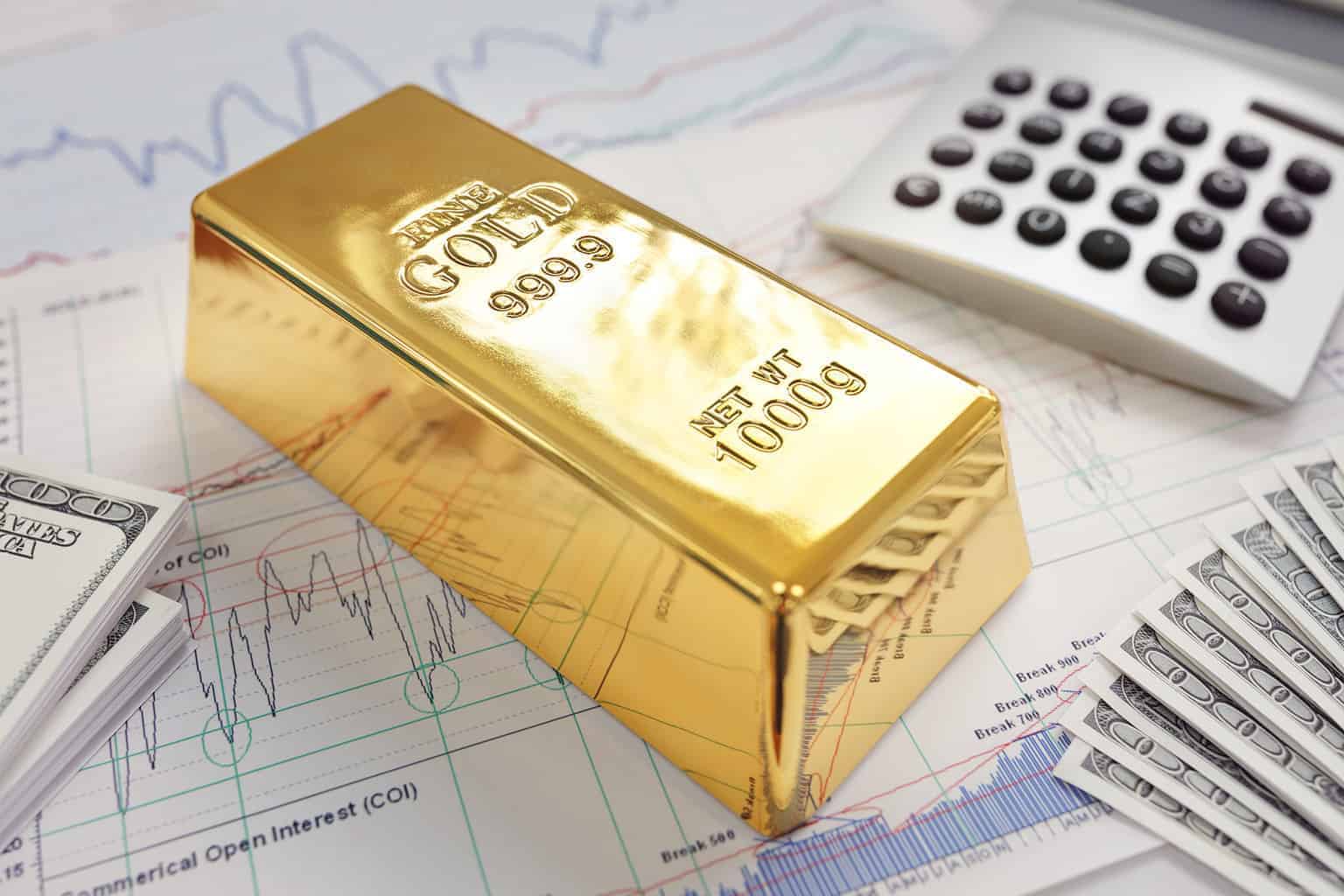Gold is one of the most popular investments in the world. From buying gold coins and bars to gold stocks and funds, there are myriad ways you can invest in the precious metal.
In this guide, you will learn everything you need to know about investing in gold, including how you can make your first gold investment today.
Why Invest in Gold?
Throughout history, gold has been considered valuable. It has been used as money since 600 BC. Until the abolishment of the Gold Standard in 1971, even the US dollar was backed by gold held in vaults.
Today, gold no longer backs sovereign currencies. Instead, the precious metal is used in the creation of jewelry and electronics, and has industrial applications. Additionally, gold has emerged as an attractive alternative investment.
“The desire for gold is the most universal and deeply rooted commercial instinct of the human race.” – Gerald M. Loeb, Wall Street Veteran and founder of brokerage firm E. F. Hutton & Co
There are five main reasons why investors add gold to their investment portfolios:
- Gold acts as a safe haven during market and/or economic turmoil
- Gold acts as a hedge against inflation
- Gold acts as a portfolio diversifier
- Increasing global demand
- Limited Supply
Gold is widely considered as a “safe haven” asset during times of economic turmoil. Whether there is a significant economic crisis, the price of gold has the tendency to rally as more and more investors are moving their money to safety.
Additionally, investors also like to place funds in gold as a hedge against inflation. When investors fear that the inflation rate may increase, gold is a popular alternative to the dollar. It is a hard asset whose price cannot be easily diluted by government policy actions.
Moreover, gold is a portfolio diversification asset because it has historically had a negative correlation with stocks. That means when the stock market is performing well, gold usually isn’t. Conversely, gold tends to outperform when stocks are struggling.
Gold has also been benefiting from an increase in global demand, primarily driven by the growing middle class in countries like India and China. Met with gold’s limited supply and the difficulty of extracting the precious metal, emerging market demand has been a key driver of the price of gold.
How to Invest in Gold
There are various ways to buy gold, and most of them do not entail you visiting a gold dealer and buying physical gold bars.
Instead, most investors who want to add gold exposure to their investment portfolios prefer to buy a financial product that either tracks the price of gold or provides indirect exposure to the gold market.
Arguably, the most popular way to invest in gold is through the purchase of a Gold ETF. Gold ETFs are exchange-traded funds that buy and store gold on behalf of their investors and sell shares in the funds that act as a proxy gold investment.
The SPDR Gold Shares ETF (GLD), for example, tracks the price of the gold bullion market to enable any type of investor to add gold to their investment portfolio. The fund was launched in 2004 and has established itself as the largest gold ETF today.
To buy shares in the SPDR Gold ETF, you have to take the following steps:
- Log onto your online brokerage account.
- Scroll through the ETF section, and click on SPDR Gold ETF.
- Decide how much of your available funds you want to put into gold.
- Place a buy order for the amount of money you want to invest in the SPDR Gold ETF.
- That’s it. You are now a gold investor!
How to Buy Gold Bars
If you want to physically own the gold you purchase, you can head down to a local gold dealer and purchase coins or gold bars.
The steps you need to take to buy gold bars are very straightforward:
- Search for gold dealers in your area.
- Check reviews online or on the Better Business Bureau website to ensure that you will only transact with reputable gold dealers.
- Shop around for the best price. Dealers will quote you the same price. Make sure you get the best deal.
- Verify the authenticity of the gold bullions you are buying. Check that the gold bars contain the name of its manufacturer, its purity, and its weight. It may also be prudent to weigh the bars before making the purchase.
- Finally, you should be discreet when purchasing physical gold. Do not post your plans to go gold shopping on social media, and head straight home after your purchase so that you can securely store your gold bars in a safe as soon as possible.
While purchasing gold bars with a local dealer in person is a convenient way to get your hands on gold, it is important to note that local bricks and mortar gold dealers tend to charge a much higher price than the market price.
Alternatively, you can buy gold bars online at an international gold dealer. The process is effectively the same as in-person gold purchases. The main difference is that you need to be extra prudent about finding a reputable seller and you need to factor in shipping costs, which can be substantial in case you purchase larger amounts.
Many international gold dealers also offer storage – usually in vaults in countries such as Switzerland or Singapore – to alleviate the issue of secure shipping and storage for gold investors. However, if you are buying physical gold and not storing it yourself, you may as well purchase gold ETFs as they have lower fees and provide you with effectively the same investment exposure to gold.
Types of Gold Investments
We have already discussed how to invest in gold by buying a gold ETF or by purchasing physical gold that you either store yourself or in a vault. Additionally, there are several other ways you can invest in gold.
The most popular gold investments include:
- Physical gold coins and bars
- Gold jewelry
- Gold futures contracts
- Gold options contracts
- Gold stocks
- Gold mutual funds
- Gold ETFs
Gold bars and coins were already being traded and held as an investment since way before the first stock ever exchanged hands. And today, people still like to buy physical gold as an investment and store it in a safe in their homes.
Purchasing gold jewelry is also a form of gold investing. You may not have considered that the last time you purchased a gold necklace but the value of gold jewelry can increase together with the price of gold over time.
Gold futures contracts – a type of financial derivative that tracks the price of gold – is one of the most popular ways to buy gold among institutional investors. However, futures contracts are not long-term investments because each contract has a maturity date – usually three months. Therefore, it is preferred by investors and traders who are looking to bet on the price of gold in the short-term.
Gold options are another type of financial derivatives that enables investors to bet on the price of gold. A gold options contract provides the holder with the right but not the obligation to buy (or sell) gold at a specific price at a predetermined time in the future. That means you could buy a call option on gold with a strike price of $2,000 for a small fee, and if the price exceeds $2,000 you make a profit on your call options when you exercise it. If the price doesn’t hit $2,000 during the option’s time horizon, it expires and you only lose the fee you paid for the option. Similar to gold futures, options are generally only traded by institutional and professional investors.
Unlike futures and options, gold stocks are for everyone. Gold stocks refer to shares in companies that are involved in the gold industry, with the majority being gold mining companies.
Gold mutual funds and ETFs are arguably the most popular investment vehicles for private investors. Gold mutual funds usually invest in a portfolio of gold companies, while gold ETFs track the price of gold by investing in gold derivatives or physical gold.
Best Gold Stocks
Gold stocks are shares in companies that are involved in the exploration, mining and dealing of gold. They provide an alternative, indirect way to add gold to your investment portfolio as they generally perform in line with the price of gold.
Below, you will find the top five largest gold stocks ranked by market capitalization.
| Company Name | Market Cap ($bn) | 3-Yr Return |
|---|---|---|
| Newmont Goldcorp (NYSE:NEM) | $49.660 | 85.62% |
| Barrick Gold (NYSE:GOLD) | $48.200 | 69.54% |
| Freeport-McMoRan (NYSE:FCX) | $18.830 | 2.93% |
| Agnico Eagle Mines (NYSE:AEM) | $15.610 | 45.67% |
| Kirkland Lake Gold (NYSE:KL) | $12.771 | 492.54% |
Newmont Goldcorp (NYSE:NEM)
Newmont Goldcorp is the world’s largest gold mining company. The Colorado-based gold miner operates mines in the United States, Canada, Argentina, Australia, Ghana, Mexico, the Dominican Republic, Peru, and Suriname.
- Market Capitalization: $49.66bn
- P/E Ratio: 14.32
- Dividend Yield: 1.62%
- 3-Year Return: 85.62%
Barrick Gold (NYSE:GOLD)
Barrick Gold is the second-largest gold mining company in the world. The Canadian gold mining enterprise operates mining operations in over a dozen countries.
- Market Capitalization: $48.2bn
- P/E Ratio: n.a.
- Dividend Yield: 0.59%
- 3-Year Return: 69.54%
Freeport-McMoRan (NYSE:FCX)
Freeport-McMoRan is an Arizona-based precious metals mining company that operates mines on four continents.
- Market Capitalization: $18.83bn
- P/E Ratio: n.a.
- Dividend Yield: 1.54%
- 3-Year Return: 2.93%
Agnico Eagle Mines (NYSE:AEM)
Agnico Eagle Mines is a Canadian gold mining and exploration company that operates in Canada, Mexico, Finland and the United States.
- Market Capitalization: $15.61bn
- P/E Ratio: 37.61
- Dividend Yield: 1.23%
- 3-Year Return: 45.67%
Kirkland Lake Gold (NYSE:KL)
Kirkland Lake Gold is a Canadian gold mining company that operates several mines in Canada and Australia.
- Market Capitalization: $12.77bn
- P/E Ratio: 42.81
- Dividend Yield: 0.26%
- 3-Year Return: 492.54%
Best Gold Penny Stocks
Penny stocks refer to public companies whose stock price is trading at $5 or less. Penny stocks usually have a low market capitalization – think small and micro cap stocks – and often trade over-the-counter (OTC) as opposed to on a major stock exchange.
There are plenty of gold penny stocks to choose from and we have listed three interesting picks below.
However, it is important to note that penny stocks are high-risk investments and should, therefore, only make up a very small percentage of a diversified investment portfolio – if at all.
| Company Name | Market Cap ($bn) | 5-Yr Return |
|---|---|---|
| Gold Resource Corporation (NYSE: GORO) | $0.291 | 86.54% |
| Golden Star Resources (NYSE: GSS) | $0.315 | 133.33% |
| Santa Fe Gold Corporation (OTC: SFEG) | $0.025 | 41.41% |
Gold Resource Corporation (NYSE: GORO)
Gold Resource Corporation is a Colorado-based precious metals exploration company that produces gold and silver. The company’s stock is traded on the New York Stock Exchange and has a market capitalization of $291 million.
- Market Capitalization: $291 million
- P/E Ratio: 142.81
- Dividend Yield: 0.96%
- 5-Year Return: 86.54%
Golden Star Resources (NYSE: GSS)
Golden Star Resources is a Canadian gold mining company that operates two mines in Ghana. The company’s stock is traded on the New York Stock Exchange and has a market capitalization of $315 million.
- Market Capitalization: $315 million
- P/E Ratio: n.a.
- Dividend Yield: n.a.
- 5-Year Return: 133.33%
Santa Fe Gold Corporation (OTC: SFEG)
Santa Fe Gold Corporation is a New Mexico-based precious metals mining and exploration company that operates in the United States. The company’s stock is traded over-the-counter and has a market capitalization of only $25 million.
- Market Capitalization: $0.025
- P/E Ratio: 9.33
- Dividend Yield: n.a.
- 5-Year Return: 41.41%
Best Gold Mutual Funds
Gold mutual funds typically invest in stocks of companies involved in the gold market. The majority of these companies are gold miners.
The top three largest gold mutual funds – measured by assets under management – include the Fidelity Select Gold Portfolio, the Invesco Oppenheimer Gold & Special Minerals Fund, and the First Eagle Gold Fund.
| Mutual Fund Name | Total Assets ($MM) | Expense Ratio |
|---|---|---|
| Fidelity Select Gold Portfolio | $2,286.10 | 0.79% |
| Invesco Oppenheimer Gold & Special Minerals Fund | $2,058.04 | 1.18% |
| First Eagle Gold Fund | $1,957.69 | 1.29% |
Fidelity Select Gold Portfolio
The Fidelity Select Gold Portfolio invests in companies that are involved in the processing, mining, or dealing in gold as well as – to a lesser degree – other precious metals. If you want to add a diversified basket of gold stocks to your portfolio, the Fidelity Select Gold Portfolio could be a good choice as it comes with a low expense ratio of 0.79%.
- Assets Under Management: $2,286.10
- Expense Ratio: 0.79%
Invesco Oppenheimer Gold & Special Minerals Fund
The Invesco Oppenheimer Gold & Special Minerals Fund typically invests in companies that are involved in the mining of gold and other precious metals.
- Assets Under Management: $2,058.04
- Expense Ratio: 1.18%
First Eagle Gold Fund
The First Eagle Gold Fund invests in gold stocks as well as gold and silver bullion. The fund’s performance should, therefore, be tied closer to the price of gold than that of gold funds that only hold gold stocks.
- Assets Under Management: $1,957.69
- Expense Ratio: 1.29%
Best Gold ETFs
Gold ETFs are probably the best way to invest in gold. They track the price of gold and, generally, incur low annual fees.
Below, you will find the best gold ETFs, ranked by total assets under management.
| ETF Name | Total Assets ($bn) | Expense Ratio |
|---|---|---|
| SPDR Gold Trust (GLD) | $69.584 | 0.40% |
| iShares Gold Trust (IAU) | $26.878 | 0.25% |
| SPDR Gold MiniShares Trust (GLDM) | $2.664 | 0.18% |
SPDR Gold Trust (GLD)
The SPDR Gold Trust ETF was launched in 2004 and established itself as one of the most popular gold ETFs in the market. The ETF holds gold bullions on behalf of its investors, and thus tracks the price of gold as closely as possible. However, it has an expense ratio of 0.40%, which is higher than that of some of its peers.
- Assets Under Management: $69.584bn
- Expense Ratio: 0.40%
iShares Gold Trust (IAU)
The iShares Gold Trust ETF aims to reflect the price of gold by holding physical gold on behalf of its investors. The iShares Gold Trust is the second-largest gold ETF by market capitalization and comes with an expense ratio of 0.25%.
- Assets Under Management: $26.878bn
- Expense Ratio: 0.25%
SPDR Gold MiniShares Trust (GLDM)
The SPDR Gold MiniShares Trust ETF provides investors with one of the lowest available expense ratios in the gold ETF market, and is thus very popular among small investors. If you want a low-cost gold ETF for your investment portfolio, the SPDR Gold MiniShares Trust is an excellent pick.
- Assets Under Management: $2.664
- Expense Ratio: 0.18%
What’s Next?
Gold is one of the most popular investments next to stocks and bonds. Whether you will purchase gold or not is ultimately up to you, but there is no better time than today to start your investing journey.
* All data was collected on July 12, 2020







